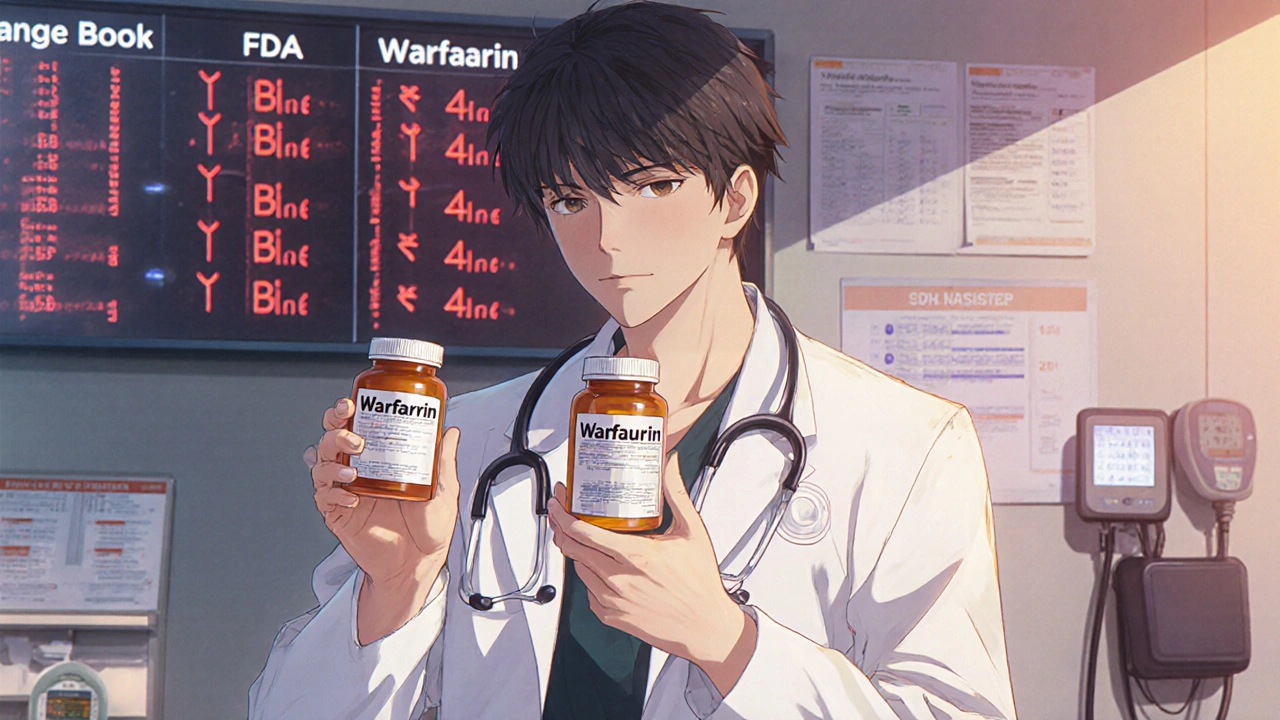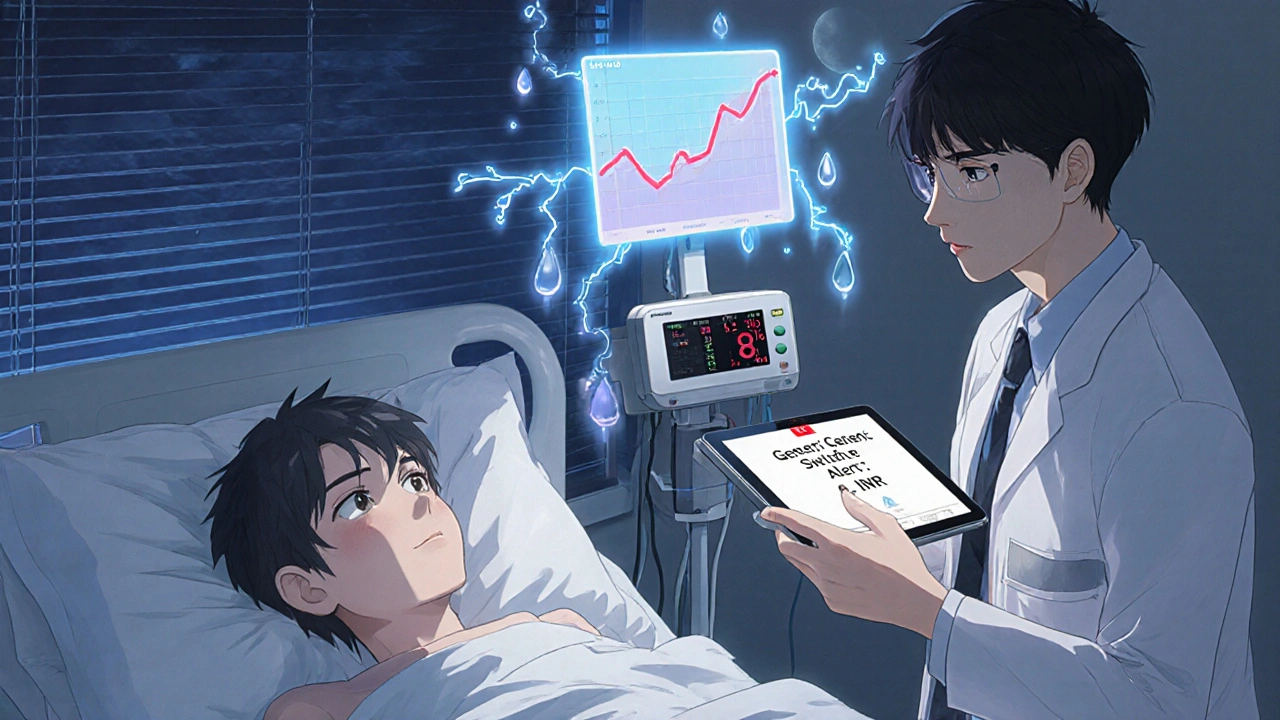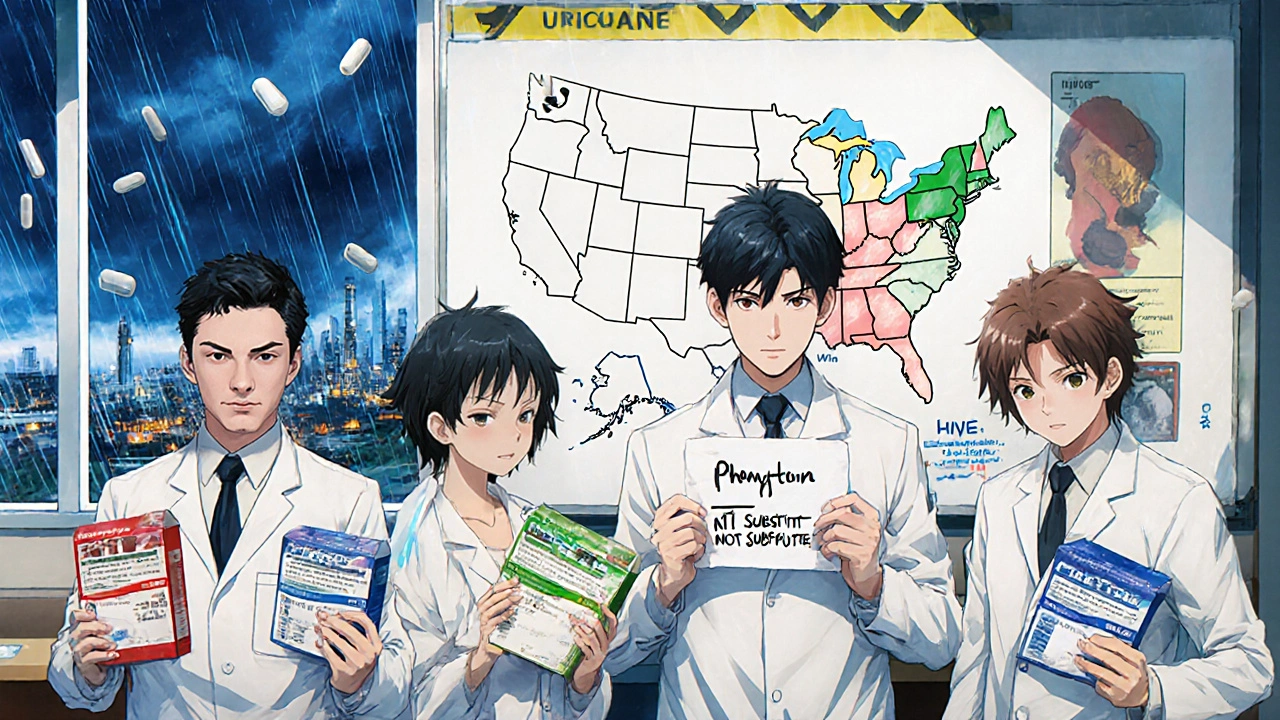
When a pharmacist hands a patient a generic pill instead of the brand-name version, most of the time, it’s a simple swap-same active ingredient, lower cost, same effect. But for NTI generics, that swap isn’t so simple. Narrow Therapeutic Index drugs leave almost no room for error. A tiny difference in how the body absorbs the medicine-just 10%-can mean the difference between effective treatment and dangerous toxicity, or worse, complete therapeutic failure. For pharmacists on the front lines, this isn’t theoretical. It’s daily reality.
What Makes a Drug an NTI Drug?
NTI stands for Narrow Therapeutic Index. These are medications where the gap between a safe, effective dose and a toxic or ineffective one is razor-thin. Think of it like walking a tightrope: too little, and the disease comes back; too much, and you risk organ damage or death.
The FDA doesn’t publish an official list, but it tracks these drugs through the Orange Book using Therapeutic Equivalence (TE) codes. Drugs marked with a ‘B’ code are flagged as having potential substitution risks. Common NTI drugs include warfarin (a blood thinner), levothyroxine (for thyroid function), phenytoin (for seizures), carbamazepine (for epilepsy and nerve pain), and cyclosporine (for transplant patients).
For most generic drugs, bioequivalence is measured within an 80-125% range compared to the brand. For NTI drugs, the FDA recommends a much tighter window: 90-111%. That’s not just a technicality-it’s a safety buffer. Even then, many pharmacists say it’s still not enough.
Why Pharmacists Are Worried
A 2024 survey by the American Society of Health-System Pharmacists (ASHP) found that 68% of pharmacists have serious concerns about substituting NTI generics. That’s not a small minority-it’s the majority. And it’s not just about cost savings. It’s about control.
One hospital pharmacist in Ohio told a colleague: “I had a patient on brand-name warfarin for three years. Stable INR. Then the insurance switched her to a generic. Two weeks later, she came in with a bleeding ulcer. Her INR was 8.2. We had to admit her.”
These aren’t isolated stories. The FDA’s Adverse Event Reporting System recorded 1,247 adverse events linked to NTI generic substitutions between 2020 and 2024. For non-NTI generics, the number was 382. That’s more than three times the risk.
And it’s not just about switching from brand to generic. It’s about switching between different generic manufacturers. The FDA reported in 2024 that 23% of NTI drug shortages were worsened by pharmacists being forced to switch between different generic versions due to supply issues. Each switch introduces variability. For a drug like levothyroxine, even small fluctuations in absorption can cause fatigue, weight gain, heart palpitations, or worse.
State Laws Are a Patchwork
Here’s where it gets messy. In the U.S., state laws govern whether pharmacists can automatically substitute NTI generics. As of January 2025, only 28 states have specific rules restricting automatic substitution for NTI drugs. In 22 states, the pharmacist must notify the prescriber before switching. Six states ban automatic substitution entirely.
That means a patient in California might get the same generic every time. A patient in Texas might get a different generic every refill-no warning, no consent, no monitoring. Pharmacists in states without protections say they feel powerless. They know the risks, but they’re legally required to dispense what’s prescribed-or what’s cheapest.
A 2025 survey by the National Community Pharmacists Association found that 73% of independent pharmacists have received direct requests from physicians to avoid NTI generic substitutions. Warfarin tops the list (68%), followed by levothyroxine (52%) and carbamazepine (47%). Yet, in many places, those requests are ignored because insurance formularies push the cheapest option.

The Cost vs. Risk Dilemma
It’s easy to say generics save money. And they do. NTI generics cost 80-85% less than brand-name versions. For patients on fixed incomes, that’s life-changing. One pharmacy owner in Arizona reported a 35% drop in patients abandoning their prescriptions when generics became available.
But money isn’t the only currency here. The cost of an adverse event-hospitalization, emergency care, long-term damage-can far outweigh the savings. The IQVIA Institute found that while NTI drugs make up only 5.3% of all prescriptions, they account for 9.7% of total drug spending. Why? Because they’re high-risk, high-stakes medications. When something goes wrong, the financial and human toll is massive.
And the supply chain is fragile. Eighty percent of generic drugs, including NTI drugs, are finished overseas. A single manufacturing delay in India or China can trigger a nationwide shortage. In 2024, there were 47 NTI drug shortages-17.4% of all shortages-even though NTI drugs represent only 6% of generic prescriptions.
What Pharmacists Are Doing About It
Despite the challenges, pharmacists aren’t sitting idle. Many hospital systems now follow the ASHP’s 2025 Toolkit recommendation: lock in one generic manufacturer for each NTI drug and stick with it. Sixty-three percent of hospitals have adopted this practice. It’s not perfect, but it reduces variability.
Therapeutic drug monitoring (TDM) is becoming standard. Pharmacists are checking blood levels more frequently-especially after a switch. For warfarin, that means frequent INR tests. For phenytoin, it’s serum level checks. Eighty-one percent of pharmacy residency programs now include specialized NTI drug training, up from just 35% five years ago.
Some pharmacies have started patient education programs. Instead of just handing over a pill, pharmacists sit down with patients and explain: “This is a different generic. We’re going to monitor your levels closely. Let us know if you feel off.” Simple, but effective.

The Future: Stricter Rules, More Responsibility
In April 2025, the FDA announced a new bioequivalence framework for critical dose drugs, targeting 12 high-priority NTI drugs with stricter standards by 2026. Pharmacists are cautiously optimistic. But there’s pushback. Lisa Schwartz of the NCPA warned that even tighter standards won’t fix the real problem: supply chain fragility and opaque pricing by group purchasing organizations.
Meanwhile, the Medicare Drug Price Negotiation Program is including three NTI drugs in its first round of price controls. The 21-day reimbursement delay under this program has already caused cash flow problems for community pharmacies, risking stockouts of these essential drugs.
The long-term solution? More pharmacist involvement. The American Society of Health-System Pharmacists predicts that 74% of healthcare systems will have pharmacist-led NTI drug stewardship programs by 2027. That means pharmacists won’t just be dispensers-they’ll be clinical decision-makers, helping choose the right drug, the right manufacturer, and the right monitoring plan.
What Patients Should Know
If you’re on warfarin, levothyroxine, or another NTI drug, ask your pharmacist: “Is this the same generic I’ve been taking?” If the answer is no, ask why. Ask if your doctor needs to be notified. Ask if your blood levels will be checked after the switch.
Don’t assume it’s safe just because it’s generic. NTI drugs demand attention. And you have the right to be part of that conversation.
Bottom Line
NTI generics aren’t inherently bad. They make life-saving drugs affordable. But they’re not interchangeable like aspirin or statins. The current system treats them like ordinary generics-and that’s where the danger lies. Pharmacists see the gaps. They’re asking for better standards, clearer rules, and more control. Until those changes come, every switch carries risk. And someone, somewhere, is paying the price.
Are all generic drugs the same as brand-name drugs?
For most medications, yes. But for Narrow Therapeutic Index (NTI) drugs like warfarin, levothyroxine, and phenytoin, small differences in how the body absorbs the drug can lead to serious side effects or treatment failure. These drugs require stricter bioequivalence standards and careful monitoring.
Can pharmacists refuse to substitute an NTI generic?
It depends on state law. In 28 states, pharmacists can’t automatically substitute NTI generics without prescriber approval. In six states, substitution is banned entirely. In the rest, they’re required to dispense the generic unless the prescription says “Dispense as Written” or the patient refuses. Many pharmacists will still consult with the prescriber even if not legally required.
Why are NTI drug shortages more common?
NTI drugs often have complex manufacturing requirements, including precise formulations and strict quality controls. Many are made overseas, and even minor production issues can cause delays. Because there are fewer manufacturers willing to produce them due to the high risk, any disruption quickly leads to shortages. The FDA reported 47 NTI drug shortages in 2024, far out of proportion to their market share.
What should I do if my NTI medication changes generic brands?
Contact your pharmacist and your prescriber. Ask if your blood levels need to be checked (like INR for warfarin or serum levels for phenytoin). Watch for new symptoms-fatigue, dizziness, irregular heartbeat, unexplained bruising. Report anything unusual. Don’t assume it’s fine just because the pill looks different.
Is there a list of NTI drugs I can check?
The FDA doesn’t publish a public list, but you can search the Orange Book using the Therapeutic Equivalence (TE) code. Drugs with a ‘B’ code are flagged for potential substitution issues. Common NTI drugs include warfarin, levothyroxine, phenytoin, carbamazepine, cyclosporine, digoxin, and theophylline. Your pharmacist can help you identify if your medication is on this list.
Comments (8)
-
Rebekah Kryger November 11, 2025
Everyone’s acting like NTI generics are some new horror story, but let’s be real - the FDA’s 90-111% window is still a 21% swing. That’s not tight, that’s a goddamn canyon. I’ve seen patients on levothyroxine go from euthyroid to myxedema coma because some batch from India had 5% more filler. And no, the ‘same manufacturer’ fix doesn’t work when the supply chain collapses. This isn’t about pharmacists being control freaks - it’s about the system being designed to fail.
-
Victoria Short November 12, 2025
My grandma switched generics last year and felt fine. Maybe we’re overcomplicating this?
-
Phil Best November 13, 2025
Oh, so now the solution is to make pharmacists the new gatekeepers of life-or-death dosing? Brilliant. Let’s just throw more responsibility onto people who already work 60-hour weeks and get paid less than the guy who delivers your Uber Eats. Meanwhile, the real villains - the PBM middlemen who force these switches and then vanish when the INR spikes - are sipping champagne in Boca. You want to fix this? Ban formularies from dictating NTI meds. Not ‘lock in one manufacturer.’ Ban the entire profit-driven charade.
-
Parv Trivedi November 15, 2025
As someone from India where many generics are manufactured, I see both sides. The quality control in some facilities is excellent - I’ve visited labs that follow WHO-GMP standards better than some U.S. plants. But the pressure to cut costs leads to corners being cut. The real issue isn’t just the generic vs. brand debate - it’s global supply chain transparency. We need a global registry for NTI drug batches, traceable to the factory floor. It’s possible. It’s just not being done. And yes, pharmacists should be empowered. But so should patients - education is key.
-
Connor Moizer November 16, 2025
Look, I get the fear. I’ve worked ER. I’ve seen the bleeding ulcers. But here’s the truth: 90% of patients never notice a switch. The 10% who do? They’re the ones with paranoid doctors who over-test and patients who Google every symptom. Stop treating every NTI patient like they’re on a tightrope over a volcano. If your INR is stable, leave it alone. If it’s not, that’s a clinical issue - not a generic issue. The system’s broken, but blaming the pharmacist or the pill is lazy. Fix the insurance algorithms. Stop letting bots decide your meds.
-
roy bradfield November 18, 2025
Let me tell you what’s really going on - the FDA is in bed with Big Pharma. They don’t want you to know this, but the ‘B’ code drugs? They’re deliberately kept in the gray zone so brand-name companies can keep charging $500 a month for warfarin while the generics are ‘technically’ equivalent but actually loaded with inactive ingredients that interfere with liver enzymes. The whole NTI crisis? A cover-up. The real reason they won’t publish a list? Because if you knew how many of these ‘generics’ contain trace amounts of industrial solvents from Chinese factories, you’d never take another pill again. And don’t get me started on the 2024 shortages - that was orchestrated to drive demand for the brand. The FDA knows. The DEA knows. Congress knows. But no one’s talking. Until someone blows the whistle, we’re all lab rats in a rigged experiment.
-
Patrick Merk November 19, 2025
I’ve worked in Irish hospitals where NTI drugs are treated like radioactive material - every switch requires a signed consent, a 72-hour observation window, and a pharmacist’s personal sign-off. It’s slow. It’s bureaucratic. But it works. We’ve had zero adverse events from generics in five years. Why? Because we treated them like the high-risk meds they are. No one’s asking for perfection - just a little respect. If your drug can kill you if you blink wrong, maybe it deserves a little more than a barcode scan and a shrug. Let pharmacists be clinicians, not cashiers.
-
Liam Dunne November 20, 2025
My brother’s on cyclosporine after his kidney transplant. They switched him to a generic last year - no warning. His levels dropped, he rejected the organ, had to go back on dialysis for six months. He’s fine now, but it cost him a year of his life. This isn’t theory. It’s my family. If your pharmacy changes your NTI med without asking, ask them why. If they say ‘it’s cheaper,’ ask them if they’d take the switch themselves. And if they hesitate? That’s your answer.
